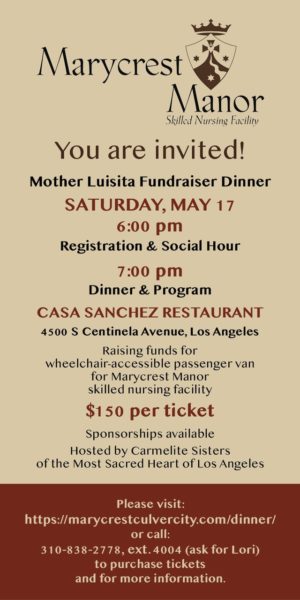“I think it’s fantastic. I think it’s pretty excellent because [Pope Francis] is a religious. He’s a Jesuit. And so, it’s such a treasure in the Church. I’m sure it was much better known decades ago. I mean, everywhere we go, people are constantly saying, ‘I haven’t seen a sister in a habit since I was a child.’ Constantly.”
What in the world is Sister Faustina of Merciful Love (Deppe), a professed 34-year-old member of the Carmelite Sisters of the Most Sacred Heart of Los Angeles, talking about with such passion?
“And so I think there’s a really serious need to make religious life more known,” she goes on. “Just because, you can’t take for granted that young Catholics have a clue that this is even a possibility. And I think it’s such a source of grace in the Church. I mean, you have all these women and men who have dedicated their lives to just serving, their praying.
“And it would bring great joy to the Church as a whole to know that there’s so many people who are trying very hard to be faithful and to love.”
Late last year, Pope Francis announced that starting Nov. 29-30 — the first weekend of Advent this year — and ending Feb. 2, 2016 — the World Day of Consecrated Life — would be a “Year of Consecrated Life.” The term often brings to mind priests belonging to religious orders such as Jesuits, Franciscans and Dominicans along with sisters (women religious) and brothers.
But there exists many diverse branches — including monastic life, hermits, institutes devoted to contemplation, secular institutes, societies of apostolic life, orders of virgins and widows and evangelical counsels as well as new or renewed forms of the consecrated life.
Consecrated life, in the canonical sense as defined by the Catholic Church, is a stable state of life characterized by the public profession of vows of poverty, chastity and obedience.
Perhaps Pope Benedict XVI captured its essence best.
“Consecrated people are called in a special way to be witnesses of the mercy of the Lord in which human beings find their salvation,” he observed on the Feast of the Presentation of the Lord in 2010. “They have a vivid experience of God’s forgiveness, because they know that they are people saved, that they are great when they see themselves as small and feel renewed and enveloped by the holiness of God when they recognize their sins.”
A sister’s day
The Year of Consecrated Life will feature special events: an open house at convents, abbeys, monasteries and religious houses on Feb. 8, days with religious throughout the summer of 2015, where laypeople can join men and women religious in works of service, plus a day of prayer next year on Sept. 13.
Combined, they’ll offer the opportunity — especially for youths and young adults — to see how religious really live and work, according to Bishop Michael Burbidge of Raleigh, North Carolina, chairman of the U.S. Conference of Catholic Bishops’ Committee on Clergy, Consecrated Life and Vocations.
The day for Sister Faustina starts a little before 5 a.m. Together with other members of her community — which is both an active out-in-the-world and contemplative order — she prays the Divine Office, also called the Liturgy of the Hours. The combination of litanies and hymns integrate the Psalms of the Old Testament into prayers seamlessly throughout the early morning, day and evening. Then there’s silent meditation followed by Mass.
After breakfast, it’s off to her apostolate or work, which as vocation directress is based at the motherhouse at 920 Alhambra Road in Alhambra, where she also lives.
The women religious come back together in the middle of the day to examine where God was that morning and how each responded. “Because Our Lord comes to us all the time and very often, it’s too fast for us at the moment,” she explains. “And then we can go back and say, ‘Whoa! I missed that’ or ‘I had the grace to cooperate.’”
Then it’s lunch and returning to work. At about 3:30 or 4 o’clock, she usually goes back to her room for more solitude, which can be a time of rest, reading or, again, recollecting the day’s happenings. Holy hour begins at 4:45 p.m. with the rosary, followed by a half-hour of more silent meditation, then evening prayer.
After dinner and the dishes are done, it’s time for recreation. Sister Faustina likes to take a stroll around the neighborhood, play a heady game of Scrabble or work on a craft. For the last five years, she’s been into making stained-glass “windows” out of paper, using an X-Acto knife and different colors of velum.
There’s time for some spiritual reading, often on saints’ lives, before coming together for night prayer. It’s another chance to study the Mass readings of the day and also to start thinking about the next day’s.
“We also take another time to examine where Our Lord was working in the afternoon and how we responded,” she reports. “The same as in the morning. That’s another 15 minutes. Then we pray from the Liturgy of the Hours. And then we say goodnight to Our Lord in the Blessed Sacrament and head off to bed by 9:30 to 10 o’clock.”
‘Incredible joy’
Sister Faustina’s life sounds like spiritual Shangri-La. But there are real challenges, which she calls “the sorrows.”
With a semi-stifled laugh, she says the first major hurdle is that you never stop being yourself — even as a card-carrying sister.
“So the spiritual life in general is challenging,” she points out. “We’re trying to cast off the old man and then we’re trying to put on Christ. There’s no magic formula for that. So, it’s patiently moving one step at a time, dealing with what we need to deal with, coming into conflicts that Our Lord allows so that we can grow. We’re married to Christ crucified. I mean, Catholics carry crucifixes. We know that our suffering is very redemptive.
“The second major challenge would just be being in touch with the pain that people have. Priests, brothers and sisters have that privileged place where people share a lot of their life with you. We love them. And it’s just part of love that you suffer with them. Because you’re with the people, you suffer.”
But Sister Faustina stresses that being a Carmelite sister has many more pleasures.
“First of all, there’s the incredible joy in giving everything to God,” says the Apple Valley native, who grew up Presbyterian. “We find joy in giving ourselves away — whether that’s in marriage or whatever state of life you have, any selfless life is full of joy. And I think when you meet religious sisters who are living authentically, they’re just bubbling over with joy.
“It’s really a life of love where nothing is lost,” she adds. “I mean, Our Lord sees everything. It’s just a chance to live very intentionally, and as our hearts our purified, the joy just intensifies. It’s incredible.”
Another huge happiness is living in community. Right now at the motherhouse in Alhambra there’s 27 sisters who have professed vows, including Sister Faustina, and nine novices. She knows very clearly that there’s “no way” she could live her religious life if it wasn’t supported by these women religious. In fact, she can’t even imagine getting up before 5 a.m. every day without them.
And then there’s the wonderful joy since August of being the community’s vocation directress.
“I am in contact with so many very, very beautiful young women who are wanting to follow Our Lord’s will, and to be at a privilege place of knowing their hearts and knowing what God’s doing,” she says quietly. “It’ like getting to step into a sacred realm.”
To find out more about the Carmelite Sisters of the Most Sacred Heart of Los Angeles or to schedule a visit, contact Sister Faustina, OCD, 920 E. Alhambra Road, Alhambra, CA 91801 Phone: (626) 300-8938.

